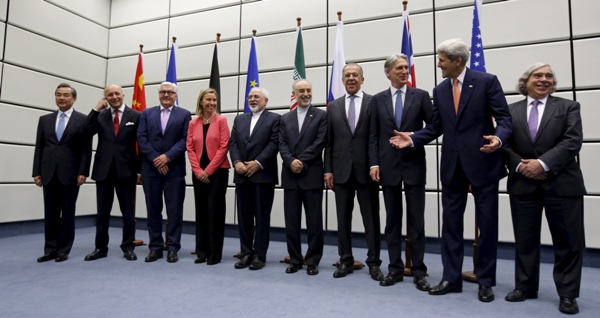Maye Kabil: Easing international sanctions on Iran was considered a breakthrough that will affect international markets and Middle Eastern economic balances. The deal settled last week between Iran and the international powers- the United States, China, Russia, France, United Kingdom and Germany (P5+1) — commits Tehran to limiting its nuclear programme gradually in return for lifting international oil and financial sanctions.
Under the terms of the deal, Iran will receive phased relief from EU, U.S. and UN sanctions, which were applied since 2012 because western countries believe the Iranian nuclear programme is directed to non-peaceful usage. These sanctions have almost halved the country’s oil exports to 1.2 million barrels per day, down from 2.5 million. The economy which is heavily dependent on oil exports was harmed from those sanctions, and the country lost its share in oil market to other players during the past three years.
Having back the country with the world’s fourth-biggest crude reserves could reshape global oil markets. The markets gave mixed signals in its reaction to the nuclear deal; initially prices fell by 2.3% to reach $50.98 a barrel, on expectation that removing sanctions will raise the supply of oil. However, it bounced off those levels as investors weighed the details of the agreement and whether or not it will pass from in the American Congress, which is supposed to vote on it after two months.
Iranian Oil Minister Bijan Namdar Zanganeh says the country can increase exports by 500,000 barrels a day as soon as sanctions are lifted, then an additional 500,000 a day in the following six months.
Sanctions will remain in place at least until United Nations monitors report on Iran’s compliance with the deal in December. The International Atomic Energy Agency will issue a report by 15th December, according to Bloomberg.
Goldman Sachs Group Inc. says adding this amount per day will take about a year because Iran must first demonstrate its compliance with the terms of the nuclear accord. This will delay for few month the risk of lower oil prices that will follow the increase in supply.
Oil and the Gulf
Lower oil prices are a source of risk to all Gulf countries, but for the
UAE this will be mitigated by Dubai’s trade and financial ties to Iran, as EFG Hermes says in a report called “The Iran factor”. Iran is the UAE’s most important non-oil trade partner: it accounted for 11% of the total UAE’s exports in 2014, and perhaps as much as double the share of non-oil exports. Most of this trade goes through Dubai, which is sure to benefit from a recovery in trade and investment in Iran.
Other GCC markets will do much less well. We also believe that UAE equities offer better value than those in Saudi Arabia.
Iran has 18% of the world reserves of natural gas, but exports a small fraction of it – net exports were 2% of 2014 production. It may choose
to supply gas to its neighbours (via pipeline or tanker), particularly if this serves political goals, according to Hermes. Potential destinations include Oman, Kuwait and the UAE. Rising Iranian gas production presents some risks to Qatari gas revenues, but we believe that this should be put in the
context of a more immediate rise in gas output in Australia and the US, and the prospect of lower demand growth from Asia. Qatar’s gas revenues may continue to fall long before Iranian exports rise.
Saudi Arabia will lose some of the gains that it benefited from the Iranian sanctions. The 1 million barrels of daily sales lost following the 2012 sanctions were split between Europe and Asia. Iran’s Asian trade was mostly taken by Saudi Arabia and Kuwait, whose crudes are chemically similar, according to the U.S. Energy Information Administration. In Europe, Iranian oil was displaced by Russia, Saudi Arabia and Iraq.
Crude exports of about 1.1 million barrels a day have continued to buyers granted exemptions by the US, China, South Korea, Japan, India, Turkey and Taiwan.
Russia and Turkey
Removing the sanctions will benefit Russia because many exporting companies will find a good opportunity in a country opening its market to consumption. Exporters for Grains, woods, metals and machineries are among those. Importers of Iranian fruits and vegetables will start to be active too.
However, the expected reduction in oil prices will harm Russia, who already got benefits of getting Iran out of the picture. The international market already has around half million barrels surplus of daily production. This was expected to be reduced gradually till the end of the year. But the return of the Iranian oil will postpone the balance in this market maybe for a coming year.
Turkey on the other side has very strong economic and trade relations with Iran. The Turkey president said last month he wants to raise the trade exchange between the two countries to $30 billion. The current Iranian exports to Turkey are around $ 10 billion, while its imports from Turkey reached $ 4 million.
Iran and Turkey also study a mechanism by which Tehran could export its gas through the lands of Turkey to Europe.
Trade and investment
Experts say that the worst among sanctions is considering Iran an area for money laundry, which exempted Iran from the international payment network SWIFT. Removing this will enable foreign banks to deal with Iran without the fear of being accused by American officials.
Big oil companies are now targeting Iran to get a part of the new exploration and development contract which are going to be made.
Iran is looking forward to attract investors. It doesn’t only concentrate on exporting its oil, but wants western expertise to revive Iran’s ageing fields and creaking infrastructure, and restore its position as the fourth biggest producer after Saudi Arabia, the US and Russia. The goal is to increase output by 50 per cent in just five years, to as much as 5m b/d.


